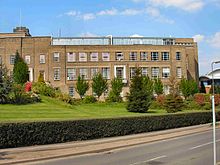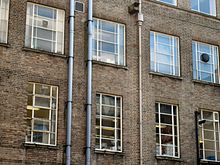Janet Parker
Janet Parker ( March 1938 - September 11, 1978 in Birmingham ) was a British medical photographer and is the last known death of smallpox .
Life
Janet Parker had worked as a police photographer but left the job because of the irregular hours. In 1975 she began to work at the Medical School of the University of Birmingham , where experiments with smallpox viruses were also carried out. Parker's work has mainly included photomicrographs of fixed slides and photographs for illustration. Occasionally she was asked to take photos of the primates in the anatomy department.
Parker was considered a good photographer and a level-headed and good colleague. She had friends among the staff in the anatomy department; however, there is no evidence that she ever visited the smallpox virus laboratory, even though it was only 15 meters from her place of work.
death
Summary
Professor Henry S. Bedson, head of the microbiology department at the University of Birmingham Medical School , was pressured by the request to destroy his smallpox populations in a timely manner.
WHO inspectors had previously judged the Birmingham Smallpox Laboratory to be “unsatisfactorily safe”, but lacked the competence to order its closure.

As it turned out later, smallpox viruses probably took on aerosol form in Bedson's laboratory and reached a photo studio and its darkroom via air ducts one floor higher. The 40-year-old photographer Parker became infected and died, despite having been vaccinated against smallpox twelve years earlier . She previously transmitted the virus to her mother, who also got sick but survived. Her father was not infected but succumbed to a massive heart attack while visiting his dying daughter in the hospital.
History of the Birmingham Smallpox Laboratory
The smallpox laboratory received financial support from the WHO, but was visited by inspectors in early May 1978, as the WHO had decided to only carry out all work with smallpox in London , Atlanta , Moscow , Tokyo and Bilthoven in the Netherlands by the end of 1978 . The World Health Organization inspectors who visited the Birmingham Smallpox Laboratory expressed concern to Henry Bedson about the lack of certain safety measures and recommended improvements. However, they saw no reason to stop research on smallpox in the laboratory until the end of 1978.
Infection and Death of Parker
Parker's illness began with flu-like symptoms on August 11th. On 15./16. August she developed "spots" on the limbs, torso and face. On August 16, her family doctor, LE Arundel, prescribed an antibiotic. Two days later, she was examined at home by GM Hoto, a doctor who prescribed other antibiotics. As she developed more spots , she was visited by her parents' family doctor, AR Price, on the morning of August 24, who admitted her to the hospital.
At 3:00 p.m. on Thursday, August 24, 1978, Alasdair Geddes, physician on duty at East Birmingham Hospital, was asked by HV Morgan to come to the hospital to raise a suspicion with Parker, who was being treated in the isolation ward to examine for smallpox.
When examined, Parker had a fever and complained of limb pain but was conscious and clear. Her temperature was 38.3 ° C. A generalized (pus) vesicular rash was seen on all areas of the skin including the palms of the hands and soles of the feet. The lesions were mainly round with surrounding reddening of the skin . The rash was half-melting on the face .
Alasdair Geddes had fluid samples taken from three vesicles and taken to the smallpox laboratory at the Medical School, where Henry Bedson performed a virological test on the samples. Under electron microscopy, cuboid-shaped particles were shown, which strongly indicated smallpox viruses. W. Nicol, who was in charge of the Birmingham Area Health Authority, was immediately informed of the state of affairs. He traveled as quickly as he could to the hospital where Parker was being treated. An emergency committee has been set up here.
At around 10 p.m., Janet Parker was transferred to Catherine-de-Barnes Hospital. Her bedding was destroyed and the room where she was cared for at East Birmingham Hospital was disinfected with formaldehyde . The Emergency Committee then compiled a list of people Parker had been in contact with. They were immediately vaccinated against smallpox, including Janet Parker's husband and parents. W. Nicol had East Birmingham closed and all patients and staff who had been there with Parker were immunized.
Since the Birmingham Smallpox Laboratory was suspected to be the origin of Parker's disease, all work there was stopped after samples were sent to other institutes for analysis.
Alasdair Geddes and Henry Bedson examined the anatomy department where Janet Parker had worked. In the front courtyard, they found that an air duct - a blue metal pipe about 18 meters long - led into the room where Parker had worked. This channel also passed the smallpox laboratory and could therefore be a source of infection. As a result, the laboratory and anatomy department were sealed and flooded with gas.
On September 11, 1978, Janet Parker succumbed to smallpox.
consequences
Professor Bedson was so desperate about the incident for which he was responsible that he cut his throat and bled to death in his tool shed. He left a note in which he wrote: "I am sorry to have disappointed the trust that so many of my friends have placed in me and my work."
See also
Web links
- Report of the investigation into the cause of the 1978 Birmingham smallpox occurrence . HM Stationery Office, London, 1980 (report on Parker's death; English; PDF; 14.3 MB)
| personal data | |
|---|---|
| SURNAME | Parker, Janet |
| BRIEF DESCRIPTION | british smallpox fatality |
| DATE OF BIRTH | March 1938 |
| DATE OF DEATH | September 11, 1978 |
| Place of death | Birmingham |

